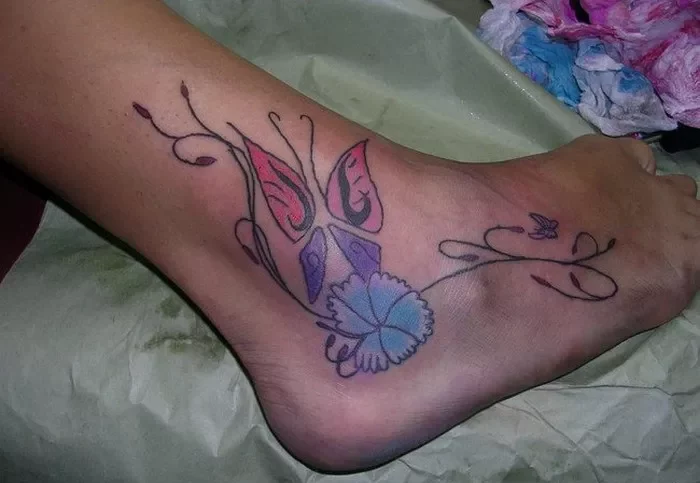In the realm of body art, tattoos serve as more than just decorative ink etched into the skin; they often carry profound meanings and symbolism. Among the myriad designs, the butterfly tattoo stands out as a symbol of beauty, transformation, and rebirth. However, beneath its aesthetic appeal lies a deeper significance, particularly concerning mental health. In this article, we delve into the rich symbolism of butterfly tattoos and explore their therapeutic implications in the context of mental well-being.
Origins and Symbolism
To comprehend the mental health connotations of butterfly tattoos, it’s crucial to grasp their historical and symbolic roots. Throughout various cultures and traditions, butterflies have been revered as potent symbols of metamorphosis, endurance, and spiritual growth. In ancient Greek mythology, Psyche, the goddess of the soul, was often depicted with butterfly wings, symbolizing the soul’s immortality and evolution. Similarly, in Chinese culture, butterflies represent love, joy, and the transient nature of life.
The metamorphosis of a caterpillar into a butterfly mirrors the journey of personal growth and transformation. This profound symbolism resonates deeply with individuals navigating mental health challenges. Like the caterpillar, those struggling with mental illness may undergo a process of inner transformation, emerging from darkness into light, from despair into hope.
Butterfly Tattoos: A Therapeutic Expression
In recent years, the therapeutic potential of tattooing has garnered increasing recognition within the mental health community. For many individuals, getting a tattoo, particularly one with symbolic significance like a butterfly, can serve as a cathartic and empowering experience.
1. Empowerment: For individuals grappling with mental health issues, reclaiming agency and autonomy over one’s body and identity can be profoundly empowering. The act of choosing to adorn oneself with a symbol of transformation and resilience can instill a sense of empowerment and self-determination.
2. Symbolic Transformation: Tattooing a butterfly onto one’s skin can serve as a tangible representation of the internal journey toward healing and self-discovery. It symbolizes the possibility of transcending hardship and emerging stronger, more vibrant, and more resilient on the other side.
3. Visibility and Advocacy: In a society where mental health struggles are often stigmatized and misunderstood, butterfly tattoos can serve as a form of silent advocacy. By visibly displaying a symbol associated with mental health and transformation, individuals can initiate conversations, raise awareness, and combat stigma.
4. Personalized Meaning: While the butterfly tattoo carries universal symbolism, its interpretation can be deeply personal and nuanced. Each individual may imbue the tattoo with their own unique meaning, reflecting their personal journey, struggles, and triumphs.
5. Mindfulness and Healing: The process of getting a tattoo, from design selection to the actual tattooing session, can be a meditative and therapeutic experience. It requires focused attention and mindfulness, serving as a form of self-care and healing for individuals grappling with mental health challenges.
Butterfly Tattoos and Mental Health Advocacy
Beyond individual expression, butterfly tattoos have also emerged as potent symbols within the broader mental health advocacy movement. In recent years, various initiatives and organizations have adopted the butterfly as a symbol of hope, solidarity, and resilience in the face of mental illness.
1. Butterfly Project: The Butterfly Project, inspired by the butterfly’s symbolism of transformation, encourages individuals struggling with self-harm and other forms of emotional distress to draw a butterfly on their skin instead of engaging in harmful behaviors. The act of drawing and nurturing the butterfly serves as a coping mechanism and a reminder of one’s inner strength.
2. Butterfly Symbolism in Mental Health Awareness: Numerous mental health awareness campaigns and organizations have adopted the butterfly as a symbol to signify hope, renewal, and the journey toward mental well-being. By leveraging the universal appeal of the butterfly, these initiatives aim to destigmatize mental illness and promote open dialogue surrounding mental health.
3. Tattoo Therapy Programs: Some mental health treatment facilities and organizations offer tattoo therapy programs as part of their holistic approach to healing. These programs provide individuals with the opportunity to receive a therapeutic tattoo, such as a butterfly, under the guidance of trained professionals. The process combines the healing power of art with the symbolic significance of the tattoo, offering participants a unique avenue for self-expression and emotional processing.
Conclusion
In conclusion, butterfly tattoos hold profound significance in the realm of mental health, serving as potent symbols of transformation, resilience, and hope. Beyond their aesthetic appeal, these tattoos carry deep therapeutic implications, offering individuals a tangible means of expressing their inner journey toward healing and self-discovery. Whether as a form of personal empowerment, silent advocacy, or communal solidarity, butterfly tattoos continue to inspire and uplift individuals navigating the complexities of mental health. As society progresses toward greater acceptance and understanding of mental illness, the butterfly tattoo stands as a beacon of hope, reminding us that even in the darkest of times, there is always the potential for transformation and renewal.

